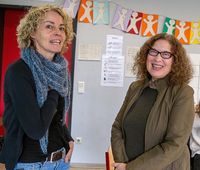Teachers who want to be able to
- consciously de-escalate conflicts
- bring about conflict resolution with empathy for others - and for themselves
- try out proven and tested methods of conflict transformation on site
practice a communicative change of perspective, which allows them to look at the roots of the conflict and to respond to it in such a way that mutual understanding becomes possible.
Introduction to nonviolent and appreciative communication
The topics:
Discrimination has many faces
What is typical for your communication style in conflict situations?
The goal of nonviolent and appreciative communication
The four components of the communicative change of perspective
Exercises with examples from the participants
The four ways of listening: How do you hear when you're being attacked?
How "real" is reality?
Nonviolent and appreciative communication in everyday school routine
The topics:
The importance of needs for nonviolent, appreciative communication
How do you reveal the needs behind the conflicts?
How empathically do you listen?
When and how do you intervene in conflicts among students?
Using role-play to discover needs and change perspective
Perceptual positions: How to create clarity in conflicts
Walburga Jansen and Doris Eichler,
Berufskolleg Kohlstraße, Wuppertal

